In today’s digital landscape, effective customer relationship management (CRM) and email marketing are pivotal for businesses aiming to thrive. HubSpot and Zoho stand out as two of the most prominent players in this arena, offering comprehensive solutions tailored to diverse business needs. As companies seek to streamline operations and enhance customer engagement, selecting the right CRM and email marketing platform becomes a crucial decision.
This article provides an in-depth comparison of HubSpot and Zoho, exploring their features, pricing structures, and overall performance. By examining these industry leaders, we aim to equip businesses with valuable insights to make informed decisions about their CRM and email marketing strategies. Additionally, we introduce Prism Reach, an innovative AI-powered tool that complements these platforms by enhancing email marketing personalization.
Key Facts
- HubSpot: Offers a free plan with essential CRM tools, with paid plans ranging from $15/month to $5,000/month, catering to businesses of various sizes.
- Zoho: Provides a more budget-friendly option, with paid plans starting at $20/user/month and scaling up to $65/user/month for advanced features.
- Both platforms feature robust automation tools, integrations, and customization options. HubSpot is renowned for its user-friendly interface, while Zoho excels in customization potential.
Platform Philosophy and Approach
When it comes to CRM and email marketing solutions, HubSpot and Zoho emerge as formidable contenders, each with distinct philosophies and approaches.
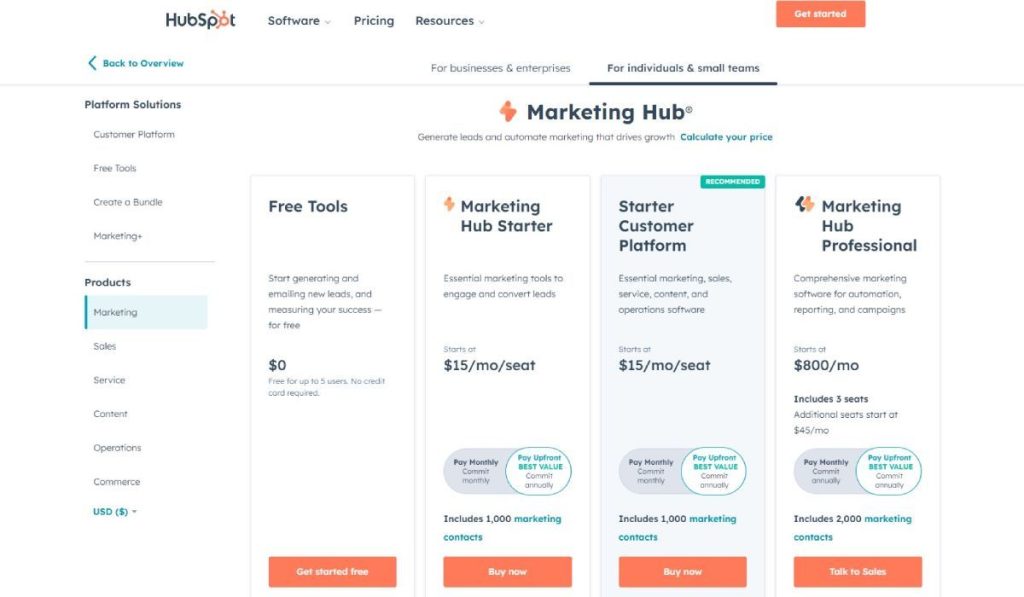
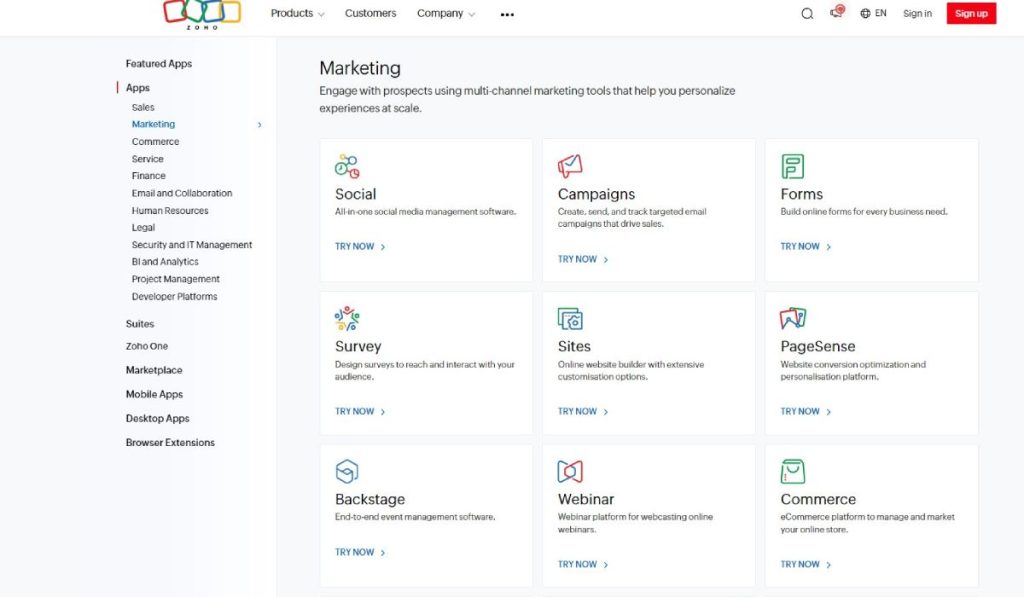
HubSpot
HubSpot is celebrated for its user-friendly interface and a comprehensive suite of marketing, sales, and service tools. According to HubSpot’s CEO, Brian Halligan, “Our goal is to make it easy for businesses to grow better by providing them with the tools they need to attract, engage, and delight customers.” This philosophy is reflected in HubSpot’s intuitive design and robust feature set, which includes advanced automation tools, detailed analytics, and a powerful content management system (CMS).
Zoho
Conversely, Zoho positions itself as a flexible and cost-effective solution, particularly for small to medium-sized businesses. Sridhar Vembu, CEO of Zoho, emphasizes the platform’s versatility: “We believe in offering businesses the freedom to choose the tools that best fit their needs, without breaking the bank.” Zoho’s extensive customization options and affordable pricing structure cater to businesses with unique requirements and budget constraints.
Email Marketing Capabilities
Email marketing remains a cornerstone of digital marketing strategies. Both HubSpot and Zoho offer robust email marketing tools, each with its unique strengths.
HubSpot
HubSpot’s email marketing tools are deeply integrated with its CRM, enabling highly personalized and targeted campaigns. The platform allows for 2,000 bulk emails per month with the free plan, scaling up significantly with paid plans. Key features include:
- Advanced SEO Tools: Enhance content visibility and search engine rankings.
- Dynamic Content Personalization: Tailor email content based on subscriber behavior and preferences.
- Adaptive Page Testing: Automatically optimize web pages for conversions based on visitor behavior and preferences.
Zoho
While Zoho’s email marketing capabilities are robust, they offer different advantages compared to HubSpot. Zoho leverages AI-driven features, such as the Zia AI assistant, which aids in data enrichment and provides intelligent insights. Key features include:
- Process Blueprints: Guide CRM users through standard processes, ensuring consistency and efficiency in team workflows.
- RFM Segmentation: Tailor marketing strategies based on customer behavior patterns, focusing on Recency, Frequency, and Monetary value.
- AI Campaign Assistant: Generate data-driven insights and recommendations to improve marketing campaigns.
Pricing Structures
Pricing is a critical factor when choosing between HubSpot and Zoho. The two platforms adopt distinct pricing models, catering to different business needs and budgets.
HubSpot
HubSpot’s pricing structure is more premium, especially at higher tiers, with significant additional costs for larger teams. Key pricing tiers include:
- Free Plan: Essential CRM tools with basic email marketing capabilities.
- Professional Plan: $1,600/month, includes unlimited email automations and advanced SEO tools.
- Enterprise Plan: $5,000/month, offers predictive lead scoring and custom reporting.
- Onboarding Fees: Can reach up to $12,000 for enterprise plans.

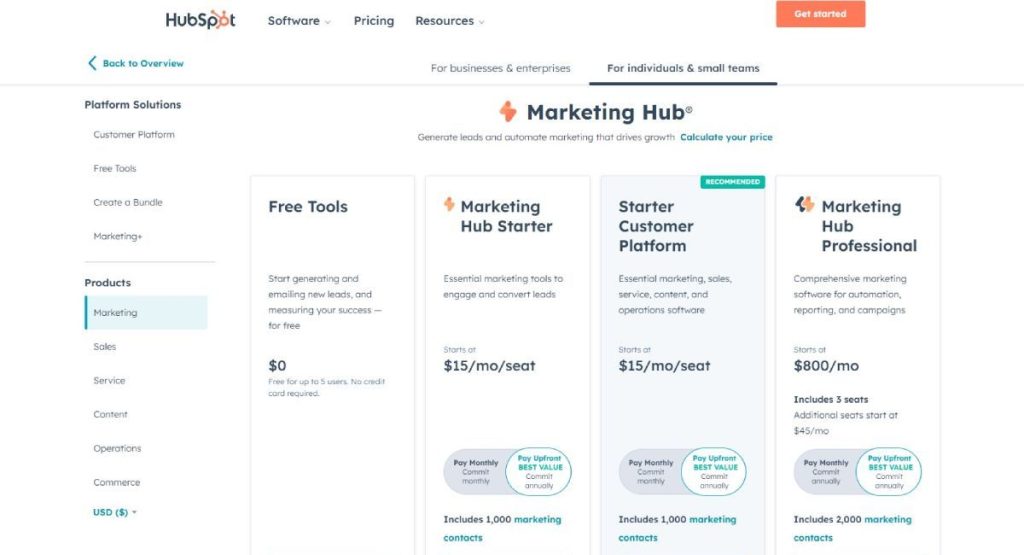
Zoho
Zoho offers a more budget-friendly pricing structure, making it an attractive option for small to medium-sized businesses:
- Customization: Flexible pricing allows businesses to scale and add features as they grow.
- Entry-Level Plans: Starting at $20/user/month.
- Ultimate Plan: $65/user/month, includes advanced business intelligence and premium support.
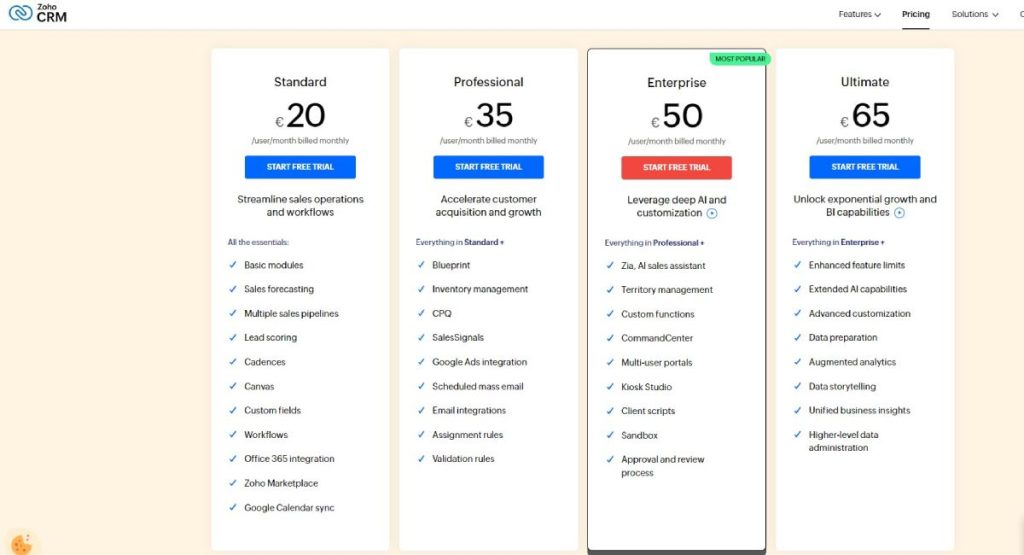
User Experience and Customization
User experience (UX) and customization capabilities play a vital role in the effectiveness of CRM and email marketing platforms. Both HubSpot and Zoho offer distinct advantages in these areas.
HubSpot
HubSpot is widely praised for its intuitive interface and ease of use. Its drag-and-drop builders and customizable features make it accessible even for beginners. Key aspects include:
- Intuitive Design: Easy navigation and user-friendly tools.
- Comprehensive Features: Advanced marketing tools integrated seamlessly with CRM functionalities.
- Adaptive Page Testing: Automatically optimizes web pages for conversions.
Zoho
Zoho, while offering a clean and simple interface, can feel somewhat outdated compared to HubSpot. However, its high customization potential allows users to tailor the platform to their specific needs:
- Extensive Customization: Create unique data structures with custom fields and modules.
- Process Blueprints: Ensure consistency and efficiency in team workflows.
- Dynamic Content Blocks: Insert automated, audience-tailored content like trending articles or product suggestions.
Integration Capabilities
Seamless integration with other tools and platforms is essential for maximizing the utility of CRM and email marketing systems. Both HubSpot and Zoho offer strong integration capabilities, each with its unique strengths.
HubSpot
HubSpot supports over 300 native integrations and an additional 5,000+ apps via Zapier, enabling businesses to connect their CRM with a wide array of tools:
- Content Remix: Repurpose existing content across multiple channels, maximizing reach and impact without additional creation efforts.
- AI-Powered Translations: Expand global reach with automated page and post translations.
- Free User Access: Provide team-wide access to reporting and results without incurring additional costs.
Zoho
Zoho also excels in integration, particularly with its own suite of applications. Key integration features include:
- AI Campaign Assistant: Generate data-driven insights and recommendations to improve marketing campaigns.
- CalDAV Sync and Feeds: Enhance team collaboration by keeping schedules and updates synchronized across all members.
- Process Blueprints: Guide CRM users through standard processes, ensuring consistency and efficiency.
Innovative Solutions by Prism Reach
While HubSpot and Zoho offer comprehensive CRM and email marketing solutions, innovative platforms like Prism Reach are pushing the boundaries of personalization and AI-driven marketing. Prism Reach’s AI-powered SaaS solution provides highly personalized newsletters for publishers, blogs, forums, and eCommerce businesses, addressing a crucial need in the evolving digital landscape.
Key Benefits of Prism Reach
- Increased Engagement: Publishers report up to 40% higher engagement rates thanks to the personalized nature of the content. By delivering newsletters tailored to subscriber preferences, Prism Reach ensures readers are more likely to interact with the content.
- Higher Revenue: Tailored advertising and precise content targeting lead to higher monetization rates for published newsletters. By aligning ad placements with individual subscriber profiles, publishers can maximize the value of their marketing efforts.
- Improved Productivity: Automation and AI-driven insights significantly reduce the time required to create and manage campaigns, freeing up resources for strategic tasks.
- Enhanced Email Marketing Efforts with HubSpot and Zoho: Prism Reach complements platforms like HubSpot and Zoho by enhancing email marketing strategies through deep personalization. It integrates seamlessly, ensuring that campaigns are both effective and efficient.
Company and Product Overview
Prism Reach is an innovative AI-powered SaaS solution that revolutionizes email marketing campaigns through advanced personalization. By leveraging proprietary AI technology, Prism Reach clusters website content and social media posts into relevant categories, creating detailed user avatars. These profiles are enriched with data such as location, engagement history, and predicted interests, enabling highly targeted newsletter content.
Prism Reach’s ability to analyze vast amounts of data sets it apart, offering unparalleled precision in content customization. Publishers and content creators can now engage their audiences more effectively, transforming the way they connect and communicate.
Target Audience
The platform caters primarily to publishers across various industries, including international media outlets, blogs, and forums. Recognizing the growing demand for personalized digital marketing, Prism Reach is also expanding into the eCommerce sector to empower businesses with its sophisticated AI technology.
Key Features
1. AI-Powered Personalization:
- Content Clustering: Advanced algorithms categorize content based on relevance, ensuring newsletters are tailored to subscriber preferences.
- User Avatars: Comprehensive profiles provide deep insights into subscriber behavior, enhancing targeting accuracy.
- Personalized Introductions: Each newsletter begins with custom introduction paragraphs generated by AI.
- Optimal Sending Times: Predictive analytics identify the best times to send emails, increasing engagement.
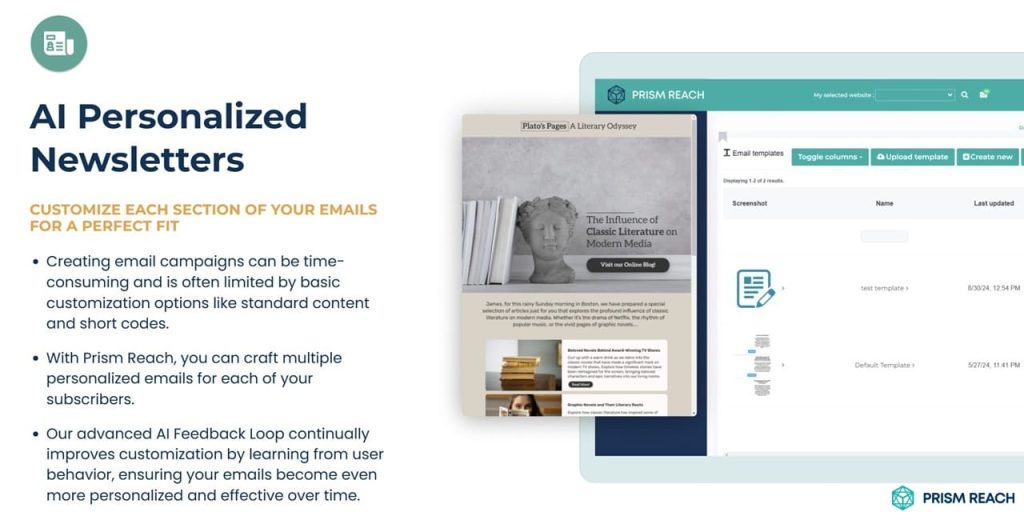
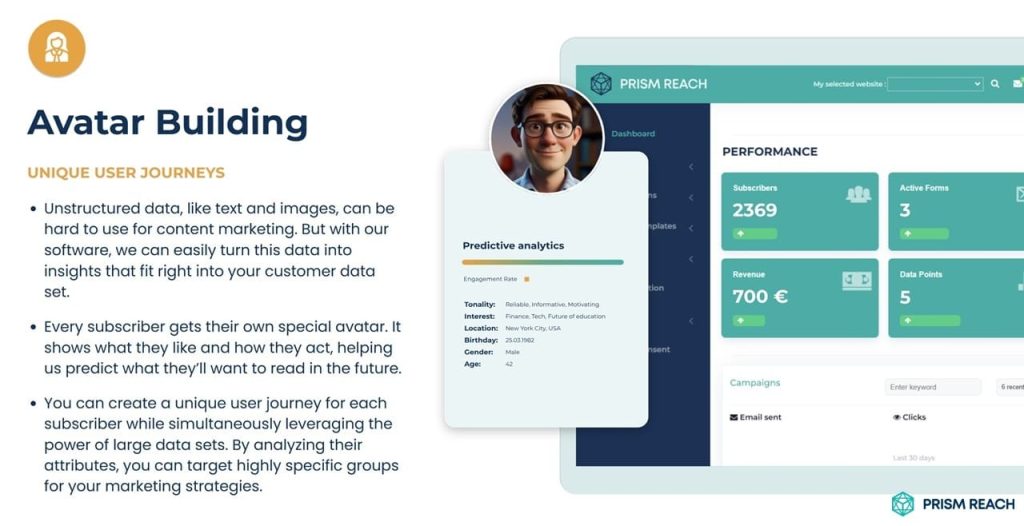
2. Seamless Setup and Integration:
- Quick Setup: The platform integrates within 10 minutes, requiring minimal technical expertise.
- One-Click Uploads: Existing subscriber lists can be imported effortlessly.
- AI-Enhanced Sign-Up Forms: These forms are optimized to increase sign-up rates and ensure GDPR compliance.
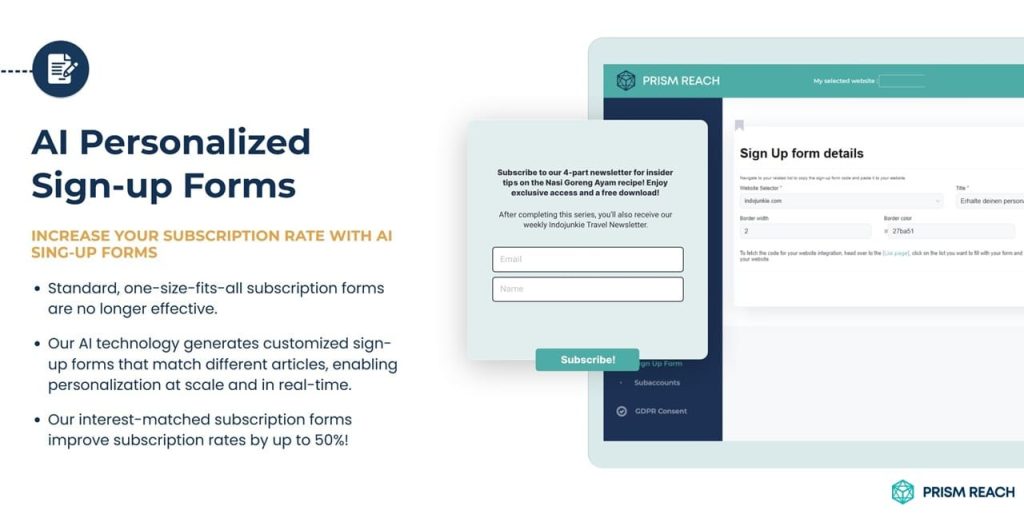
3. Dynamic Content Selection:
- The AI selects the most relevant content for each subscriber, making every newsletter unique.
4. Advertising and Swap Networks:
- Targeted Advertising: Similar to major online ad networks, Prism Reach enables precise ad placement.
- Swap Network: Publishers can mutually promote content, broadening reach and boosting engagement.
5. Advanced AI Features:
- Incorporates anti-spam checks and focuses on high deliverability, ensuring newsletters reach inboxes without triggering spam filters.
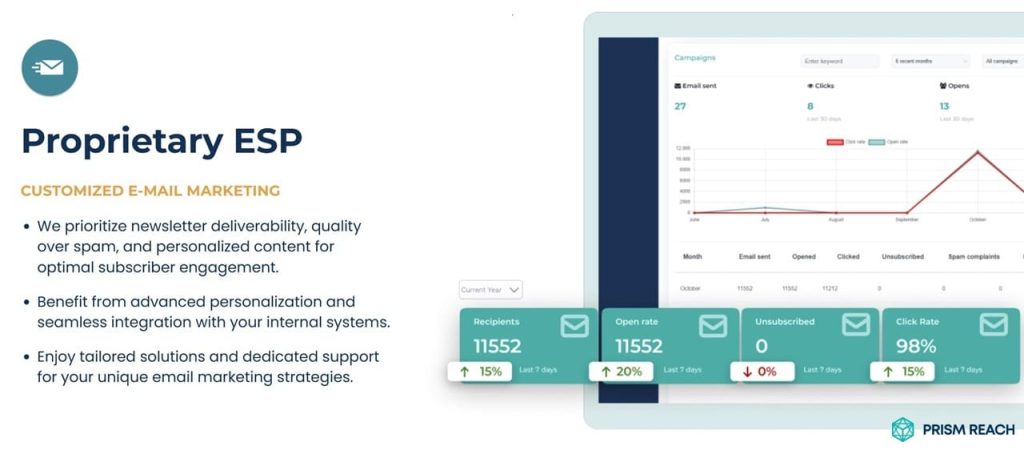
User Journey
Subscribers begin their journey by signing up through AI-optimized forms, selecting their interests, and receiving newsletters personalized to their preferences. This process enhances satisfaction, builds trust, and promotes long-term subscriber retention.
Compliance and Data Privacy
Prism Reach prioritizes GDPR compliance, hosting data within Europe and adhering to stringent privacy standards. By focusing on data protection, the platform builds trust and meets international regulatory requirements.
Future Prospects
Looking forward, Prism Reach aims to expand its influence in the eCommerce sector and explore innovative ways to apply AI across broader marketing applications. Continuous development of its AI algorithms ensures that Prism Reach remains at the forefront of marketing technology.
Upgrade Your Email Marketing with AI Personalization!
Incorporating AI-powered tools like Prism Reach into your email marketing strategy can revolutionize how you engage with your audience. By leveraging sophisticated AI algorithms, Prism Reach transforms your newsletters into highly personalized content streams that resonate with each subscriber’s unique interests and behaviors.
Whether you’re using HubSpot or Zoho as your primary CRM and email marketing platform, Prism Reach offers complementary features that enhance personalization, engagement, and overall campaign effectiveness.
Upgrade Your Email Marketing with AI Personalization!
FAQ
Conclusion
The choice between HubSpot and Zoho ultimately hinges on a business’s specific needs, budget, and growth stage. HubSpot offers a more comprehensive and user-friendly solution, ideal for businesses seeking an all-in-one platform and willing to invest in advanced features. Its robust marketing tools, intuitive interface, and scalability make it an excellent choice for growing businesses with complex marketing requirements.
Zoho, on the other hand, provides a more cost-effective and customizable solution, particularly suited for small to medium-sized businesses or those requiring extensive customization. Its AI-driven features and flexible pricing structure make it an attractive option for businesses looking to optimize their CRM and email marketing efforts without straining their budgets.
As the digital marketing landscape continues to evolve, innovative solutions like Prism Reach highlight the growing importance of hyper-personalization and AI-driven content delivery. By leveraging such technologies alongside established CRM platforms, businesses can create more engaging, personalized, and effective email marketing campaigns.
Incorporating Prism Reach with either HubSpot or Zoho can significantly enhance your email marketing strategies, ensuring that your campaigns are not only effective but also resonate deeply with your audience.